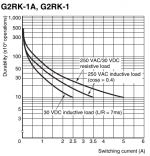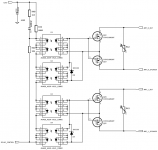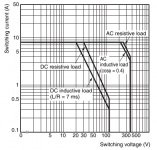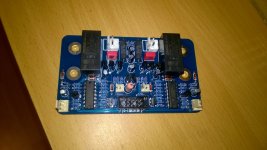http://www.unisonic.com.tw/datasheet/UPC1237.pdf
http://www.utc-ic.com/en/
http://www.utc-ic.com/2011/0505/7.html
uPC1237 is not used in heart defibrillators or airplanes AFAIK. it just protects speakers and it does that very well with old fashioned bipolar technique. Let's say it is more reliable than the amplifier it protects
BTW Unisonic is not Utsource.
http://www.utc-ic.com/en/
http://www.utc-ic.com/2011/0505/7.html
uPC1237 is not used in heart defibrillators or airplanes AFAIK. it just protects speakers and it does that very well with old fashioned bipolar technique. Let's say it is more reliable than the amplifier it protects
BTW Unisonic is not Utsource.
Last edited:
Loudspeaker lives matter !
Let's print T-shirts and banners and go out on the streets to protest!!!
You will never find anyone(distributor) actually testing out these parts unless they come straight from the mfg who takes on that responsibility.
I never expected any supplier to test any parts. As you stated this is the sole responsibility of the manufacturer.
Ok, I got it that UTC claims to be "A professional semiconductor company".
So why can't I but their products from professional sources?
I also understand that renowned brands use(d) this design in their products.
Where do they buy the ICs from? From the Chinese ebay backyard shop?
BTW, upC1237 is not static sensitive, it is not CMOS.
Wrong.
Bipolar devices can be damaged by ESD, too.
They are just much more robust.
Parametric or functional failure of bipolar and MOS ICs can occur as a result of ESD.
Parametric Degradation:
On precision, high speed ICs (...) ESD can cause device degradation, besides functional failures. This can impact electrical performance and adversely affect device reliability.
Source:Breakdown of the emitter-base junction of a NPN transistor is a common ESD related failure mode on bipolar ICs, since the highest current density occurs on the smallest current carrying area which is typically the emitter-base junction. Low current gain (hFE) is very sensitive indicator of emitter-base junction damage on bipolar linear ICs.
https://cds.linear.com/docs/en/quality/esdprotection.pdf
Some ICs are only/mostly produced for companies using them. Anyway I already gave this link:
2pcs UPC1237HA C1237HA PROTECTOR IC NEW C1237 | eBay
You can be brave and take the risk of investing 1.6 Euro. You can use one of those on a PCB in an IC socket and try it out, punish it to the extreme and see if it suits your needs. Then the search for a certified, tested and rad-hard version begins ! I would always solder this one in as its function is way too important to have it ruined by an IC socket that has bad contacts.
Or you can try this device from untested sources (ha ha what do we expect for 6.13 $ and free shipping) just to see if it protects and does what it his supposed to do. To my surprise those Songle relays have silver contacts and they are not bad at all. Incredible that expensive speakers can be protected for just 5.75 Euro ! It has delayed on switching (aka anti plop) and immediate shutdown as it must have. If we only had had this wisdom before our woofers burnt....
http://www.ebay.com/itm/UPC1237-Dua...Board-Boot-Mute-Delay-DC-12-24V-/171499918259
Then you can design Germany's best "Lautsprecher Schutz mit Einschaltverzögerung" and make Germany great again ! Oops what did I say ?!
2pcs UPC1237HA C1237HA PROTECTOR IC NEW C1237 | eBay
You can be brave and take the risk of investing 1.6 Euro. You can use one of those on a PCB in an IC socket and try it out, punish it to the extreme and see if it suits your needs. Then the search for a certified, tested and rad-hard version begins ! I would always solder this one in as its function is way too important to have it ruined by an IC socket that has bad contacts.
Or you can try this device from untested sources (ha ha what do we expect for 6.13 $ and free shipping) just to see if it protects and does what it his supposed to do. To my surprise those Songle relays have silver contacts and they are not bad at all. Incredible that expensive speakers can be protected for just 5.75 Euro ! It has delayed on switching (aka anti plop) and immediate shutdown as it must have. If we only had had this wisdom before our woofers burnt....
http://www.ebay.com/itm/UPC1237-Dua...Board-Boot-Mute-Delay-DC-12-24V-/171499918259
Then you can design Germany's best "Lautsprecher Schutz mit Einschaltverzögerung" and make Germany great again ! Oops what did I say ?!
Last edited:
We do expect suppliers to maintain records of traceability.Let's print T-shirts and banners and go out on the streets to protest!!!
I never expected any supplier to test any parts.
They need to know from whom their product came !
Yes the manufacturer can be held to account and to uphold their warranty. But that only works if the supplier knows who the manufacturer is, i.e. traceability. Who made the product?As you stated this is the sole responsibility of the manufacturer.
ISO accreditation started as British Standard some decades ago. It became an ISO standard and I now see many non european companies adhere to it.Ok, I got it that UTC claims to be "A professional semiconductor company".
So why can't I but their products from professional sources?
I also understand that renowned brands use(d) this design in their products.
Where do they buy the ICs from? From the Chinese ebay backyard shop?
Part of ISO accreditation is maintaining traceability records.
I don't rust this seller.
I mean: Look at the photo. The device is placed on a bare wooden table. No sign of ESD awareness. I bet he stores those bulk in a cardboard box right besides the dog food.
This looks surprisingly good.
Parts are worth more than the complete module costs.
With free shipping it's a steal.
But it's for baby amplifiers only with up to +/- 15V supplies.
The reason is the relays.
Those relays are rated for 30VDC maximum.
Look at this graph taken from the famous Omron G2R:
The contact can switch 1A at 30VDC for inductive loads.
Other relays behave roughly the same.
Maybe some can do 2A. But that's about it.
My amp runs from +/- 90VDC and the transformers (two of them) can deliver 10A continuously.
See what I mean?
However, everyone who has a baby amplifier: Use those modules from ebay. I bet they are great.
Then you can design Germany's best "Lautsprecher Schutz mit Einschaltverzögerung" and make Germany great again ! Oops what did I say ?!
Would you vote for me if I was a candidate?
What I would do:
- Become friends witch my "enemies"
- Insult my "friends"
- Force companies to bring back economy to Germany to make Germany great again
- Claim to drain the swamp that has drained us way too long but surround myself with swamp people
- Make a German semiconductor company produce the rad-hard uPC1237
I reworked the requirements list.
Unfortunately I cannot make a table inside the post.
See attached pdf file.
Attachments
As already explained earlier, an electromechanical relay cannot reliably switch off a DC fault current in case.
I did a lot of research but didn't find any that can.
Quite common in such applications are:
Omron G2R
Panasonic JT-N
If you like to see what happens when such a relay shall protect the speaker watch here:
Speaker DC protection with relays
There are special relays available for high DC currents but the are not designed for AC.
Examples:
Omron G9EJ / G9EJ-1-E
Fujitsu FTR-J2
Panasonic EP / AEP
How they work: They are filled with special gas and the have a special magnetic trick implemented that kills the arc. But this works only for DC and only in one direction. The relay contacts have polarity.
So for DC in both directions one needs two "back to back" in series. Not a favorable solution.
Huge relays also have a big downside: They are bad for small signals.
At the moment I use an improvised solution consisting of a huge 230VAC relay controlled by a stairway timer for delay.
This totally sucks because every time I like to listen to music I need to break the oxide layer on the relay contacts by cranking up the volume until it breaks. Most of the time the contacts stay okay for an hour. Sometimes they begin to lose contact on silent passages.
So the solution is to use solid state relays.
They are very reliable, switch small signals as well as large ones and, dependent on MOSFET selection, can switch really big loads.
I have up to 200V from the amp plus 100V safety margin and need to be able to interrupt over 10A DC.
This is why I chose the IXFK160N30T. They should do. Hopefully. The MOV shall protect them from voice coil voltage kick back at 250V in case.
Two in series give 40mOhm.
I'd prefer a lower Ron but need to make compromises with DS voltage rating and current.
Each two in parallel would make a huge hole in my wallet.
U2 and U4 are optional and can be bridged if not needed.
I can't find a good Zener diode for protecting the gates that has extra low leakage not more than 10nA at 16V with a Zener Voltage of less than 20V. Any ideas?
Here is the circuit I plan to use for SSR:
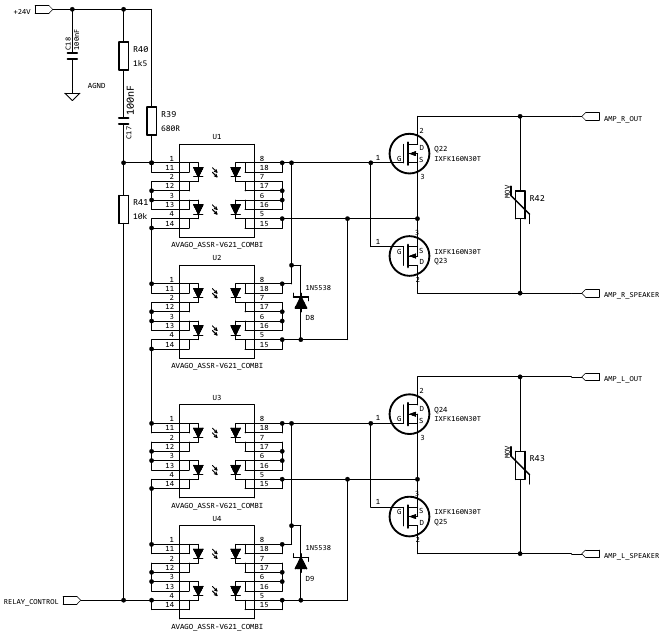
I did a lot of research but didn't find any that can.
Quite common in such applications are:
Omron G2R
Panasonic JT-N
If you like to see what happens when such a relay shall protect the speaker watch here:
Speaker DC protection with relays
There are special relays available for high DC currents but the are not designed for AC.
Examples:
Omron G9EJ / G9EJ-1-E
Fujitsu FTR-J2
Panasonic EP / AEP
How they work: They are filled with special gas and the have a special magnetic trick implemented that kills the arc. But this works only for DC and only in one direction. The relay contacts have polarity.
So for DC in both directions one needs two "back to back" in series. Not a favorable solution.
Huge relays also have a big downside: They are bad for small signals.
At the moment I use an improvised solution consisting of a huge 230VAC relay controlled by a stairway timer for delay.
This totally sucks because every time I like to listen to music I need to break the oxide layer on the relay contacts by cranking up the volume until it breaks. Most of the time the contacts stay okay for an hour. Sometimes they begin to lose contact on silent passages.
So the solution is to use solid state relays.
They are very reliable, switch small signals as well as large ones and, dependent on MOSFET selection, can switch really big loads.
I have up to 200V from the amp plus 100V safety margin and need to be able to interrupt over 10A DC.
This is why I chose the IXFK160N30T. They should do. Hopefully. The MOV shall protect them from voice coil voltage kick back at 250V in case.
Two in series give 40mOhm.
I'd prefer a lower Ron but need to make compromises with DS voltage rating and current.
Each two in parallel would make a huge hole in my wallet.
U2 and U4 are optional and can be bridged if not needed.
I can't find a good Zener diode for protecting the gates that has extra low leakage not more than 10nA at 16V with a Zener Voltage of less than 20V. Any ideas?
Here is the circuit I plan to use for SSR:
Attachments
Look at this graph taken from the famous Omron G2R:
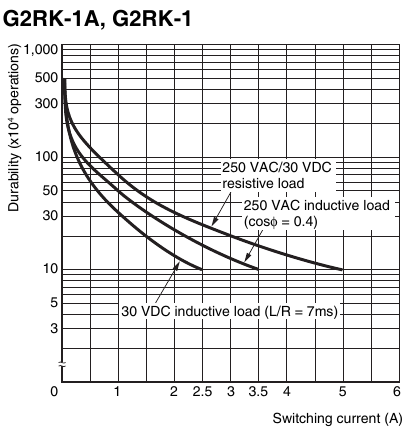
The contact can switch 1A at 30VDC for inductive loads.
Other relays behave roughly the same.
Maybe some can do 2A. But that's about it.
I just noticed I got the wrong diagram.
Please excuse.
This is the correct one:
At 30VDC it can do almost 4A.
At 90VDC it can switch only 0,4A.
Attachments
Hi, I once knew a guy that was very careful (in the most fanatic way) with his hearing. When we made noise with technical equipment he was the first to grab his ear protection which is good but he always did in a very exaggerated way. Nevertheless you had to ask him questions several times as he did not seem to understand what you were telling ?!?!
I once asked him why he was so religiously fanatical with ear protection. He replied that he used to go to sleep while listening to loud music on high volume but always fell asleep. When he woke up the loud music was still playing ion high volume in repeat mode. He explained to me that his ears were severely damaged and that he was partly deaf....
When the damage is done protection becomes paramount
It was just for testing out. Even if you would have burnt it (which I doubt) you would have known if this IC is indeed as good as Sony, Pioneer, Yamaha and others seem to think. I have tried out shorting power transistors in ready made amplifiers to see if this protection works and it was always fast enough but if you say relays are too slow I am sure they are. It seems to me that 5.75 Euro to test an item if it does what it should do (even when the relays are too low rated in your opinion) is almost for free. Those relays are fine and I hope you do not use your 2 x +/- 90V 10A amplifiers on full volume. The UPC1237 thankfully already switches at 0.7 V DC so before that possibly enormous short circuit current can do any damage. In your way of thinking it is very unwise to make a device that can create so much destroying power while you use it only playing 1 W max. I have done some measuring in the past and of all my audio friends, even the ones that say they play loud, only one played at more than 1W power but he was already somewhat deaf. His neighbours always complained about loud music. So essentially one creates a monster (+/- 90V @ 10A) that only can be fought with a monster.
Please do not buy a car !
I once asked him why he was so religiously fanatical with ear protection. He replied that he used to go to sleep while listening to loud music on high volume but always fell asleep. When he woke up the loud music was still playing ion high volume in repeat mode. He explained to me that his ears were severely damaged and that he was partly deaf....
When the damage is done protection becomes paramount
I just noticed I got the wrong diagram.
Please excuse.
This is the correct one:
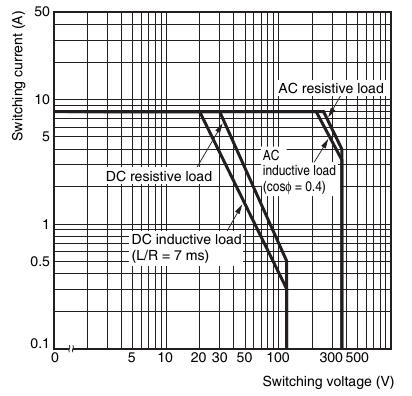
At 30VDC it can do almost 4A.
At 90VDC it can switch only 0,4A.
It was just for testing out. Even if you would have burnt it (which I doubt) you would have known if this IC is indeed as good as Sony, Pioneer, Yamaha and others seem to think. I have tried out shorting power transistors in ready made amplifiers to see if this protection works and it was always fast enough but if you say relays are too slow I am sure they are. It seems to me that 5.75 Euro to test an item if it does what it should do (even when the relays are too low rated in your opinion) is almost for free. Those relays are fine and I hope you do not use your 2 x +/- 90V 10A amplifiers on full volume. The UPC1237 thankfully already switches at 0.7 V DC so before that possibly enormous short circuit current can do any damage. In your way of thinking it is very unwise to make a device that can create so much destroying power while you use it only playing 1 W max. I have done some measuring in the past and of all my audio friends, even the ones that say they play loud, only one played at more than 1W power but he was already somewhat deaf. His neighbours always complained about loud music. So essentially one creates a monster (+/- 90V @ 10A) that only can be fought with a monster.
Please do not buy a car !
Last edited:
Please do not buy a car !
A lot of people living in big cities and never leaving them drive around (I mean wait in traffic jam) with 3t heavy >400PS powerful cars.
But the analogy is correct.
It does not make sense to use a 1000W amp for listening at 1W.
I build the amplifier for the buildings sake.
And hey - it will never leave class A and I will never run out of headroom if it does.
I like the story about your colleague.
The relays are not fine BTW.
A reasonable amp has maybe 40V to 50V supplies.
At 40V the relay can switch 2A, at 50V 1,5A.
Simply not enough.
The story about that colleague is true.
I am now building an amp that only has a few Watt. My normal amplifier that sounds very very good is only 2 x 25W. Small , light and good sounding. Simple protection too
* Do you know what testing is ? It makes no sense saying the relay is too light. It could have been 0.5 A max relays. Even if they fail during testing you will know if the circuit works and make a final version that can switch +/- 90V @ 100A.
I am now building an amp that only has a few Watt. My normal amplifier that sounds very very good is only 2 x 25W. Small , light and good sounding. Simple protection too
* Do you know what testing is ? It makes no sense saying the relay is too light. It could have been 0.5 A max relays. Even if they fail during testing you will know if the circuit works and make a final version that can switch +/- 90V @ 100A.
Last edited:
* Do you know what testing is ? It makes no sense saying the relay is too light. It could have been 0.5 A max relays. Even if they fail during testing you will know if the circuit works and make a final version that can switch +/- 90V @ 100A.
You are right the boards will do fine for evaluation purposes.
But I cannot evaluate something in real life.
The only thing I have available is a crappy multimeter and soldering iron.
I need to rely on theory a lot.
When I built my amp modules I tested them of course.
For my boss it was okay to come in on weekends and use the lab equipment.
For the company where I'm employed now it isn't.
Really ?!
BTW I never experienced a defective tweeter from powering a preamp without a muting relay while the power amp was switched on. Always the woofers went to nirvana. Once a friend had built Class A amps with "the slowest servo around". He had a few brownouts/dips at night causing his amps to very very slowly correcting the DC level of the amplifier outputs and frying the woofers while doing so. I really had to look and test carefully with load resistors to test this behaviour as the amplifiers both were still working OK Even fuses were not blown ! Imagine waking up, making coffee, switching the equipment on and no sound. Fiddling around and after some time discover that the speakers are blown and everything else is intact.
Even fuses were not blown ! Imagine waking up, making coffee, switching the equipment on and no sound. Fiddling around and after some time discover that the speakers are blown and everything else is intact.
What happened with your equipment ?
BTW I never experienced a defective tweeter from powering a preamp without a muting relay while the power amp was switched on. Always the woofers went to nirvana. Once a friend had built Class A amps with "the slowest servo around". He had a few brownouts/dips at night causing his amps to very very slowly correcting the DC level of the amplifier outputs and frying the woofers while doing so. I really had to look and test carefully with load resistors to test this behaviour as the amplifiers both were still working OK
What happened with your equipment ?
Last edited:
Really ?!
BTW I never experienced a defective tweeter from powering a preamp without muting while the power amp was on. Always the woofers went to nirvana.
What happened ?
This was just the lack of power on delay that made some start-up oscillation of the active crossover reach the speakers.
- Home
- Amplifiers
- Solid State
- Improved speaker protection circuit
